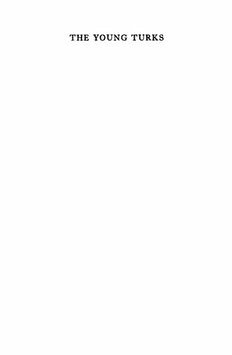
The Young Turks: The Committee of Union and Progress in Turkish Politics, 1908-1914 PDF
Preview The Young Turks: The Committee of Union and Progress in Turkish Politics, 1908-1914
THE YOUNG TURKS THE YOUNG TURKS THE COMMITTEE OF UNION AND PROGRESS IN TURKISH POLITICS 1908-1914 FEROZ AHMAD OXFORD AT THE CLARENDON PRESS 969 ï Oxford University Press, Ely House, London, W. i GLASGOW NEW YORK TORONTO MELBOURNE WELLINGTON CAPE TOWN SALISBURY IBADAN NAIROBI LUSAKA ADDIS ABABA BOMBAY CALCUTTA MADRAS KARACHI LAHORE DACCA KUALA LUMPUR SINGAPORE HONG KONG TOKYO © OXFORD UNIVERSITY PRESS 1969 PRINTED IN GREAT BRITAIN TO MY MOTHER AND FATHER PREFACE book is a study of a political society called the Committee This of Union and Progress between (Ittihad ve Terakki Cemiyeti) the years 1908 and 1914. Because of the role it played in the Young Turk revolution which forced Sultan Abdiilhamid1 to restore the 1876 Constitution, the CUP emerged as the dominant political group in the Ottoman Empire. But the Committee's position did not remain unchallenged for long. Political forces which had previously been obscured by the struggle against the Palace came to the surface, and there began a period of political activity, socio-economic change, and debate unequalled in the history of modem Turkey. This study endeavours to show that, though the Committee emerged from the revolution as the most powerful single group, its monopoly of political power was not automatically guaranteed. Political and social conditions prevailing within and outside the Empire forced the CUP to share power with such traditional ruling groups as the bureaucratic élite, symbolized by the Sublime Porte ( ) and the army. Furthermore, the Committee was BabIâli not a monolithic political organization, and the internal divisions prevented it from putting up a united front and assuming power. It was only in 1913-14 that the Committee succeeded in resolving the major internal conflicts and cleavages. In the six years under review, the social and political attributes of the CUP were also undergoing constant change. By 1914 the Committee had nar rowed down its affiliations and was in a position to establish the so-called ‘triumvirate’ of Enver, Talât, and Cemal. These figures were in themselves manifestations of factions in the CUP. This book is based on a study which was accepted by the University of London as a Ph.D. thesis. It has been thoroughly revised and much new material has been added. The original study was written under the guidance of Professor Bernard Lewis, who not only supervised but always encouraged and inspired. It is my very pleasant duty to express my thanks and 1 A very brief sketch of most of the personalities encountered in the text is given in the Biographical Appendix. viii PREFACE acknowledge my gratitude to him. The thesis was revised while I was Senior Reseach Fellow at the School of International Affairs, Columbia University, New York, during the year 1966-7. I should like to thank Dean Andrew Cordier and the School for their generous hospitality and for a most pleasant year. At Colum bia it was my good fortune to work with Professor Dankwart A. Rustow, and the study owes much to his innumerable suggestions and vast store of knowledge. My grateful thanks are due to Professor Rustow for putting at my disposal both his time and his notes gathered over the years. I wish to thank Professor J. C. Hurewitz for reading my manuscript and making many helpful suggestions; and Professor Charles Issawi for valuable advice on technical matters. It is also my pleasure to acknowledge my debt to Dr. Mohammad Sadiq of Aligarh University, who was both a colleague and a friend while we researched in Turkey, and who helped my researches in a number of ways. Let me also express my thanks to the staffs of the Public Record Office, the library of the School of Oriental and African Studies, the Senate House Library (London); and the libraries of Belediye and Beyazıt (Istanbul). Finally, it remains for me to thank my wife without whose active help and good humour this book would never have been completed. CONTENTS PREFACE Vİİ ABBREVIATIONS Xİ NOTES ON TRANSCRIPTION, PLACE-NAMES, AND DATES xiii I. THE ANTECEDENTS OF THE REVOLUTION OF 1908 I II. THE CONSTITUTIONAL RÉGIME AND THE COUNTER REVOLUTION OF 1909 14 III. (İ) THE MILITARY AND THE COMMITTEE OF UNION AND PROGRESS 47 (İİ) THE PERIOD OF CONSTITUTIONAL REFORM 57 IV. THE GROWTH OF OPPOSITION 65 V. THE DECLINE, FALL, AND RESURGENCE OF THE COMMITTEE OF UNION AND PROGRESS Ç2 VI. THE CONSOLIDATION OF POWER 121 VII. THE POLITICS OF UNION AND PROGRESS 152 BIOGRAPHICAL APPENDIX l66 SELECT BIBLIOGRAPHY 182 INDEX 194
